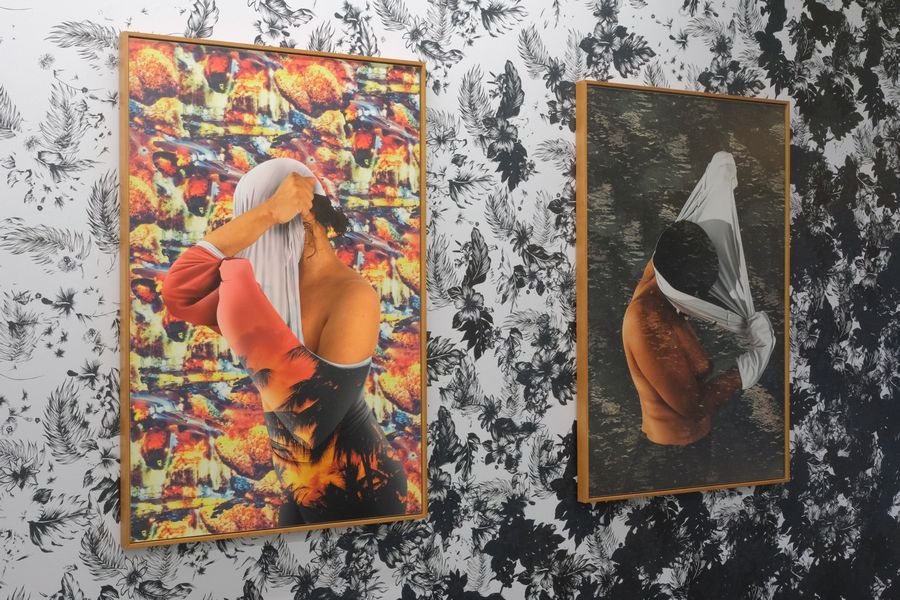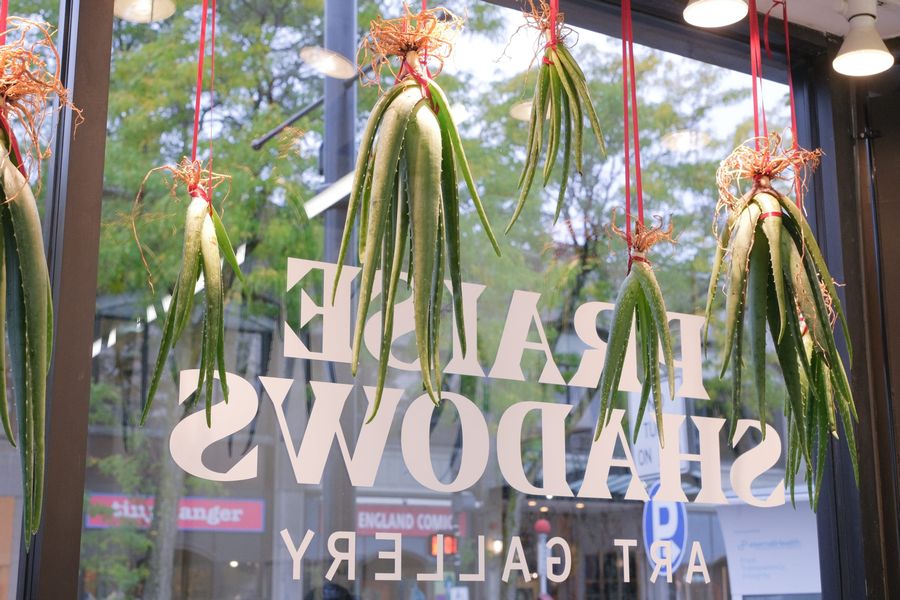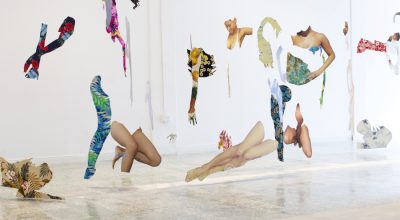
JOIRI MINAYA: THE GREAT CAMOUFLAGE
Praise Shadows Art Gallery presents The Great Camouflage by Joiri Minaya (1990), her first solo exhibition with the gallery, featuring three new large-scale photographic collages; never before exhibited paintings, photographs, and wallpaper; and the video Sábila / Leche. In this exhibition, Minaya explores her relationship to changing landscapes as a migrant, a diasporic subject, all while grappling with the contested and intertwined colonial histories of the Caribbean and the Northeast United States.
A New York-born artist raised in the Dominican Republic, Minaya collects printed fabric, brochures, postcards, textures, digital imagery, and much more — products of a material culture that exoticizes tropical people and spaces with the romantic visual constructions of the Global North. Concurrent in her practice is the study of plants employed by Black and Indigenous people as tools of liberation and resistance. Her celebrated public art series The Cloaking applies this visual vocabulary by shrouding colonial public statues in colorful “tropical” skins with patterns so subtle as to be subversive: plants used by the Black and Indigenous populations as weapons of defense.


The Atlantic Ocean binds the histories and peoples of Africa, the Caribbean, and New England. This exhibition traces those same currents of marronage, alternate mythologies and beliefs, ritual, and strategic (in)visibility as vessels for redemption and empowerment. The historic figure Tituba carves her way through the exhibition at multiple points. She was an enslaved woman from Barbados who was the first person to be accused of practicing witchcraft during the Salem witch trials of 1692-1693. She was forced to confess and implicate other women, thereby validating the Puritans’ fanatical conviction that witchcraft was indeed rampant.
The 2022 work Shield is inspired by the early 20th century Maji Maji rebellion against Germany’s colonial regime in East Africa, located in modern-day Tanzania. The rise of mystical leader Kinjikitile Ngwale and his “war medicine” were central to the alliance of indigenous tribes that resisted the colonizers. The medicine was believed to be a magical liquid, brewed from castor leaves and mtama (sorghum or millet), that promised invisibility and protection from bullets. Oral history also documents the practice of making turbans out of these plants. This tradition is represented in Shield through the rippling blue water pattern and the repetition of the cup-like castor plant on the performer’s bodysuit, which she appears to be holding up in a protective manner, or attempting to remove in a moment of apparent physical tension.
The patterned bodysuit has been a motif in Minaya’s work since 2015 when she began the ongoing series Containers, a body of work featuring women in bodysuits with stereotypical tropical prints, constructed according to poses found from Google Image searches for “Dominican women.” The impact is jolting — a sudden dissociation in which one’s preconceptions of the “exotic” get stripped away, deconstructed, and sometimes even erased. In Divergences, a series expanded in this show, Minaya explores “taking off the bodysuit” of the Container series as a gesture of agency and tension.


Aloe plants have been a recurring motif in her practice as well. In 2015, Minaya used aloe in her video Sábila / Leche as a healing substance before burning her hair into straightness, alongside the action of nurturing her hair with milk back into its natural curly state. Sábila / Leche created opposite reflections about identity, race, beauty, and ritual. The elements of aloe and milk reference female roles of power and knowledge like that of the healer or the mother, respectively, while the changing state of the hair points to transformation and chameleonic qualities.
The aloe plant installation in the window gallery evokes a practice that marks entrances and welcoming spaces in the Dominican Republic. Upside-down aloe plants are hung behind doors and from the ceiling near the entrance of people’s homes in the countryside because people believe they keep evil spirits or bad energies away. Sometimes they’re tied with a red ribbon. Some live like this for years, without soil or water, evoking a kind of magical quality.



JOIRI MINAYA: THE GREAT CAMOUFLAGE
Praise Shadows Art Gallery, 313A Harvard Street, Brookline, MA, USA
October 5 through November 13, 2022
También te puede interesar
JOIRI MINAYA: I’M HERE TO ENTERTAIN YOU, BUT ONLY DURING MY SHIFT
Baxter St at the Camera Club of New York (CCNY) presents a solo exhibition by Joiri Minaya (Dominican Republic/United States,1990), a multi-disciplinary artist whose recent works focus on destabilizing historic and contemporary representations of...
RESISTIR EL PARAÍSO
"Resistir el paraíso" es una exhibición con artistas de Jamaica y la República Dominicana que trabajan sobre la intersección del turismo, sexualidad, género, preocupaciones ambientales, la música e Internet. La muestra, curada por Marina...
JUAN JOSÉ BARBOZA-GUBO: RETORNO-ETERNO-RETORNO
Juan José retorna a la selva y recoge escamas de Paiche, madera de diferentes tipos, caucho líquido que sale de los árboles, un bote tallado a mano y la observación y escucha de los...



